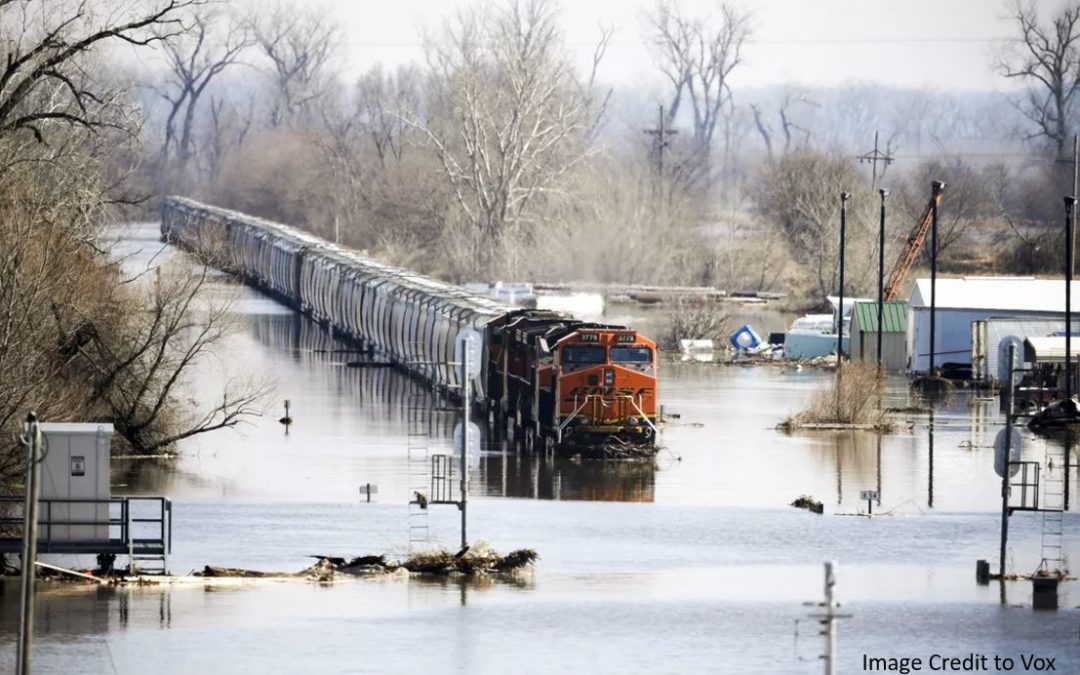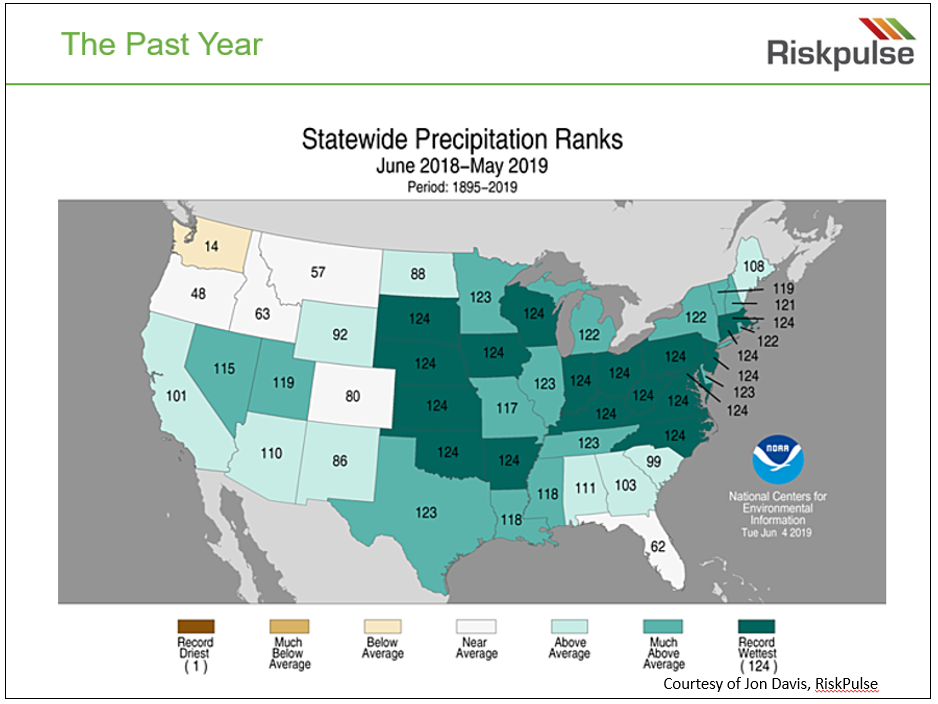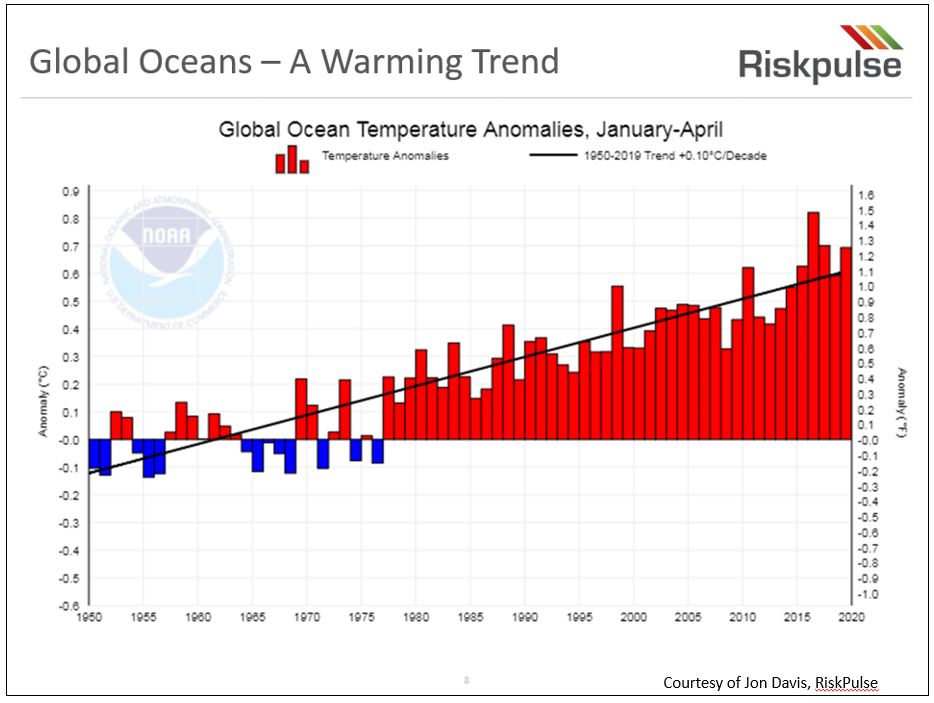What are the impacts of sustainability on the supply chain? How do things like hurricanes and flooding impact the production and distribution of fresh food? Does climate change play a role? How does food waste contribute to the environmental problems?
I think that, intuitively, we know the answers to these questions, but do we know how much of a role food waste plays and climate change’s impacts and trends over time?
Sustainability: The Impact of Weather on the Supply Chain
At a recent meeting of the Cold Chain Council, an interactive forum for thought leaders in the food and beverage supply chain, Jon Davis, Chief Meteorologist at RiskPulse, a supply chain performance company specializing in multi-factor prescriptive analytics, gave a fascinating presentation titled “Wild Weather is the New Normal.”
Jon’s presentation started with an alarming fact: According to the World Economic Forum Global Risk Report 2019, as recently as 2009, environmental issues did not rank in the top five global risks. Now, a mere ten years later, items in the environmental sector, Natural Disasters, Lack of Climate Change Mitigation and Extreme Weather Events are the top 3 risks to global business, ahead of any economic, geopolitical, societal and technological risks. That should be a wakeup call.
Jon’s presentation cited the following points:
- The past year was the wettest year in U.S. history going back to 1895. In particular, the Midwest of the US has been (and continues to be) drenched. Jon presented a map of the United States with each state’s ranking in terms of severity of the winter dating back 124 years. Note the number of states that experience record (severely bad) winters this past year…or close to it. Interestingly, the only state with a milder than normal winter was Washington.
- The trend in the U.S., as well as the Mid-latitudes of the globe, is getting wetter with time.
- As a result, excess moisture risk is increasing; this includes flooding (both long-term and short-term), disruptive storm events, extreme rain events, tropical systems, flood outages to rail/road/air, etc.
Jon then presented a case study: For the Midwest, this year’s corn crop is projected to be the worst since 1990 due to heavy precipitation. Jon’s observations: The record flooding will cause millions of lost acres that are not able to be planted.
- For the crops that are planted, the poor initial conditions will reduce yields/production for the season.
- The delays in planting will skew the crop season later so that the fall harvest will be much later than normal this year.
- Transportation will continue to be impacted via flooded roads/rails, disruptions of barge traffic, changes in freight rates and timing due to the disruptions in the agriculture season, etc.
In fact, most of the major rivers in the central US continue to be flooded, making barges unusable for shipping products via waterways. What’s the impact on this? According to IHS Markit, One barge has the capacity of 15 jumbo rail hoppers or 58 truck trailers. One 15-barge tow is equivalent to 2 1/4 100-car unit trains or 1,050 trucks! Additionally, due to flooding, some major rail lines are shut down. This means a shift to trucks, already in short supply due to driver shortages. So, it’s not just the ability to produce food that is at risk but also the ability to transport it.
But it’s not just limited to the Midwest. Changes are having an impact across the country. I asked Jon about the situation in California. For the moment, at least, we have plenty of water in California, but warmer temperatures create risks for the types of crops we can grow in California. Many, like berries and wine grapes, require cooler evening temperatures. And, in May, we saw unusual heavy rains that wiped out half of the California cherry crop.
The Impact on Environmental Sustainability: The Cause
Jon’s conclusion: The reason behind the wetter conditions is a warming trend in the global oceans.
Red and the severity of the trend line is not good. In fact, it is downright scary. Climate change and increasing ocean temperatures are leading to these extreme weather events. And fresh food waste is a leading contributor of greenhouse gasses that contribute to climate change.
Sustainability and the Supply Chain: What the Fresh Food Industry Can Do
RiskPulse helps companies in the supply chain understand and mitigate these types of risk, helping companies in the food and beverage industry navigate through these challenges. But, for those of us in the supply chain, what else can we do to minimize the impact of our actions to improve sustainability and minimize our impact on climate change?
For one, we can help reduce food waste. 40 percent of the food we produce is wasted. According to the NRDC, 37 percent of our fruits and 34 percent of our vegetables are wasted. This waste goes into landfills and contributes 8 percent of greenhouse gas emissions. And, that wasted food isn’t used to feed an increasing global population.
Solutions like Zest Fresh exist to prevent food waste and keep perishables out of our landfills. Organizations like ReFed get unused food that can no longer be sold to food banks who can get the food into the hands of the hungry. Between prevention and re-appropriation, we can help improve supply chain sustainability and feed more people with our existing food supply.
If we weren’t motivated before, Jon’s presentation should be ringing in our ears like a fire alarm to motivate us to improve sustainability and supply chain operations.
You can Jon Davis’ presentation and learn more.




